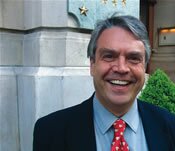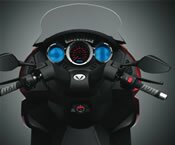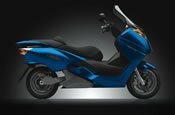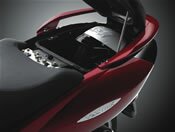Inflight Magazine of Brussels Airlines
Welcome to the Inflight Magazine of Brussels Airlines
Green machine
Ex-Ducati boss and chief operating officer of eco-friendly scooter company Vectrix explains to Boyd Farrow why cars are no longer the stars
 Afortnight after Live Earth and Carlo Di Biagio is still lamenting the fact that Al Gore never bestrode the stage at New Jersey’s Giants Stadium on a Vectrix zero-emission electric scooter.
Afortnight after Live Earth and Carlo Di Biagio is still lamenting the fact that Al Gore never bestrode the stage at New Jersey’s Giants Stadium on a Vectrix zero-emission electric scooter.
“We were this close,” he says, before remembering that at this very moment a shiny new Maxi-Scooter is winging its way to California, addressed to a certain Mr Schwarzenegger at the Governor’s mansion. Surely America’s greenest serving politician and long-time biker will find this particular photo opportunity hard to resist. “It would make a difference getting the brand out there, especially in America,” says Di Biagio wistfully.
Of course, what Vectrix’s chief operating officer is far too polite to point out is that having his own name linked to such a groundbreaking vehicle is a pretty big deal too. Until March 2003, Di Biagio was CEO of Ducati Motor Holding, maker of some of the world’s most lusted-after motorbikes, and Tom Cruise and Brad Pitt’s two-wheeled vehicle of choice. Di Biagio is credited with kick-starting the Italian company’s financial recovery in the late 90s, overseeing Milan and New York listings.
 So when Di Biagio insists the battery-powered electric bike is the future, he sounds as if he’s genuinely awed by its blockbuster potential and not merely chastened by an inconvenient truth. “I think in 10 years, maybe earlier, the centre of European towns will allow only electric vehicles or hybrids,” he says. “We can’t change towns and we’ll never be able to make engines clean enough – scooters are better than cars, but are still bad in terms of pollution – so what choice is there?
So when Di Biagio insists the battery-powered electric bike is the future, he sounds as if he’s genuinely awed by its blockbuster potential and not merely chastened by an inconvenient truth. “I think in 10 years, maybe earlier, the centre of European towns will allow only electric vehicles or hybrids,” he says. “We can’t change towns and we’ll never be able to make engines clean enough – scooters are better than cars, but are still bad in terms of pollution – so what choice is there?
“Vectrix is leading a revolution,” he adds. “We’re offering clean, efficient, reliable and affordable transport that’s stylish and fun. Ducati is about leisure – riding at weekends, picking up girls in bars – but during the week, in towns, people need an alternative to traditional scooters.”
The surprisingly cool-looking bikes on the Vectrix website (www.vectrix.com) are nothing like the prototype Di Biagio saw in 2001 when a Vectrix delegation from Rhode Island, USA, visited Ducati. “They’d been working on it for five years and it was really crude,” Di Biagio explains. “But when we tested it I saw the potential; it just wasn’t right for Ducati. Two years later they came back no longer looking for an industrial partner but marketing expertise. It was the right time for me to do something different, so I joined the company and we raised initial development money from private equity funds.”
 The venture has attracted more than cash. Partners include the engineering giant Parker Hannifin, as well as Protonex, developer of a raft of innovative fuel cell products, Alcoa, which developed the body structure of the Ferrari 360 Modena, and Getrag Corp, transmission manufacturer for Porsche and BMW. For good measure, the bikes also use Pirelli tyres.
The venture has attracted more than cash. Partners include the engineering giant Parker Hannifin, as well as Protonex, developer of a raft of innovative fuel cell products, Alcoa, which developed the body structure of the Ferrari 360 Modena, and Getrag Corp, transmission manufacturer for Porsche and BMW. For good measure, the bikes also use Pirelli tyres.
The first vehicle to market is the Vectrix VXe, a battery-powered Maxi-Scooter Di Biagio says performs like a 400cc gas-powered scooter at a quarter of the cost. The company claims a top speed of 62mph, acceleration from 0 to 60mph in just over eight seconds and a range of up to 70 miles. It should take two hours to charge the scooter from any household electrical socket. The bikes cost around €10,000 – more than many 400cc motorbikes and scooters combined – but there’s no petrol to buy and many countries have green incentives.
Being Italian, looks are obviously crucial to Di Biagio. “The design is very, very good,” he says. “It isn’t strange any more – people are familiar with the Maxi-Scooter. Obviously, the battery pack is a certain size and the bike is built around it, but this will be refined further. The cost of the battery is still high, but this will come down as soon as we sell them. We need sales from early adopters for our investment. Traditionally, prices of new models drop as later models hit the market.”
 With six patents involving more than 100 claims, Vectrix has three different machines on the horizon: sport motorcycle concepts, a three-wheel vehicle concept and a luxury version of the Maxi-Scooter, fitted with carbon parts, high-quality mechanics and exclusive accessories.
With six patents involving more than 100 claims, Vectrix has three different machines on the horizon: sport motorcycle concepts, a three-wheel vehicle concept and a luxury version of the Maxi-Scooter, fitted with carbon parts, high-quality mechanics and exclusive accessories.
“Right now, though, the focus is on this model,” says Di Biagio. “We have to be cautious about predictions because we’re a public company, but since this April we’ve produced 750 bikes and shipped 150, including some to ‘opinion formers’. We plan to produce 10,000 in the 12 months from October.”
Di Biagio admits continuing to secure investment for such an ambitious plan has been a challenge. “It’s a painful exercise – you keep spending money to carry the project at the same time as raising money to develop the products,” he says. “We raised around €35 million this spring in a London IPO.”
He says the company’s main costs come from the components it buys and then assembles at Parker’s plant in Wroclaw, Poland – battery packs from China and electronics from the US. “After marketing, our break-even point can be very low,” he says. “We should break even selling just 7,500 bikes a year.”
To help achieve this target, flagship stores have just opened in Rome, Bologna, Madrid and Melbourne. Established high-end dealers have also been appointed in London, Lisbon, Miami, Los Angeles and San Francisco.
 Di Biagio acknowledges there are differences in selling electric bikes in different markets. “Where there’s a scooter culture, as in Italy, we encounter a pricing issue – it takes time to convince buyers of the advantages. In others countries, no one even mentions the price. Also, the further north you go, the more people tend to care about the environment. We have many requests from Nordic countries, yet the market isn’t big because of the weather – there are probably only two months a year riding weather. That’s why places such as Miami and Los Angeles are so important”.
Di Biagio acknowledges there are differences in selling electric bikes in different markets. “Where there’s a scooter culture, as in Italy, we encounter a pricing issue – it takes time to convince buyers of the advantages. In others countries, no one even mentions the price. Also, the further north you go, the more people tend to care about the environment. We have many requests from Nordic countries, yet the market isn’t big because of the weather – there are probably only two months a year riding weather. That’s why places such as Miami and Los Angeles are so important”.
The ultimate aim, he says, is for Vectrix to become the generic term for electric bikes. “We have all the characteristics of a ‘cool brand’ and an iconic brand both in terms of design and the fact being green is fashionable. And, yes, we’re still working on Gore,” he laughs.
With such enthusiasm-fuelled marketing experience, one wouldn’t bet against Di Biagio eventually riding off into the sunset – battery-powered, of course – a very rich man.
FR>> Energie verte
Jusqu’en mars 2003, Carlo Di Biagio était président de la Holding Ducati Motor. Aujourd’hui, il est persuadé que les deux-roues à énergie électrique alimentés par batteries, constituent la perspective du futur.
“Je pense que dans 10 ans, le centre des villes européennes ne pourra admettre que des véhicules électriques ou hybrides,” explique-t-il. “Vectrix est en train de mener une révolution – nous offrons un transport propre, efficace, sûr et abordable et qui présente en plus un beau design, amusant.”
Et cependant les scooters que Vectrix produit aujourd’hui sont loin de ressembler aux prototypes que Di Biagio a vu pour la première fois. “Cela faisait cinq ans que les développeurs travaillaient sur le projet et au départ, le prototype était un peu brut mais lorsque nous l’avons testé, j’ai vu l’énorme potentiel,” confie-t-il, “j’ai donc décidé de rejoindre la compagnie et nous avons rassemblé le capital initial à partir de fonds d’investissements.”
Les partenaires incluent le géant de l’ingénierie Parker Hannifin, Protonex, qui développe des produits innovants dans le secteur de la production d’énergie, Alcoa, constructeur des châssis de la Ferrari 360 Modena, et Getrag Corp, fabricant de transmissions pour Porsche et BMW. Les scooters sont également équipés de pneus Pirelli.
Le premier véhicule commercialisé est la Vectrix VXe, un maxi scooter à énergie électrique, avec une puissance maximale de 100 km/h et une batterie qui se recharge en deux heures. Trois autres modèles sont en route.
Continuer à assurer des investissements pour un plan aussi ambitieux a représenté un réel défi. Les principaux coûts auxquels l’entreprise a dû faire face sont les composants achetés en Chine et aux USA, ensuite l’assemblage dans une usine de Varsovie.
De plus, on ne vend pas un scooter électrique de la même façon sur tous les marchés. “Lorsqu’il existe déjà une forte culture du scooter, comme en Italie, nous rencontrons des obstacles de prix,” dit Di Bagio, “tandis que dans d’autres pays, ce sont les conditions climatiques qui limitent le marché.”
NL>> Groene motor
Tot maart 2003 was Carlo Di Biagio chief executive van Ducati Motor Holding. Nu is hij ervan overtuigd dat de elektrische motorfiets op batterijen de toekomst is.
“Binnen 10 jaar zullen Europese stadscentra volgens mij enkel nog elektrische of hybride voertuigen toelaten”, verklaart hij. “Vectrix luidt een revolutie in: wij bieden schoon, efficiënt, betrouwbaar en betaalbaar transport aan dat trendy en leuk is.”
De motorfietsen die Vectrix vandaag produceert, lijken in niets op het prototype dat Di Biagio eerst zag. “Er was vijf jaar aan gewerkt en de motorfiets zag er bijzonder rudimentair uit. Bij het testen zag ik er echter meteen het potentieel van in”, zegt hij. “Ik stapte dus in het bedrijf en verzamelde het startkapitaal voor de verdere ontwikkeling via private equity-fondsen.
Partners zijn onder meer industriereus Parker Hannifin, Protonex, dat innovatieve brandstofcelproducten ontwerpt, Alcoa, die de carrosserie voor de Ferrari 360 Modena ontwikkelde, en Getrag Corp, transmissiefabrikant voor Porsche en BMW. Pirelli levert de banden.
Het eerste voertuig op de markt is de Vectrix VXe, een maxiscooter met batterijaandrijving en een topsnelheid van 100 km/u. In twee uur is de batterij volledig opgeladen. Drie extra modellen zijn in ontwikkeling.
Fondsen werven voor zo’n ambitieus plan bleek niet eenvoudig. De grootste kosten zijn de onderdelen, die het bedrijf koopt in China en de VS en vervolgens assembleert in Warschau.
De verkoop van elektrische motorfietsen varieert sterk. “In scooterlanden zoals Italië is de prijs een belangrijk punt”, aldus nog Di Biagio. “In andere landen is de markt kleiner door het weer.”
Leave a Reply
